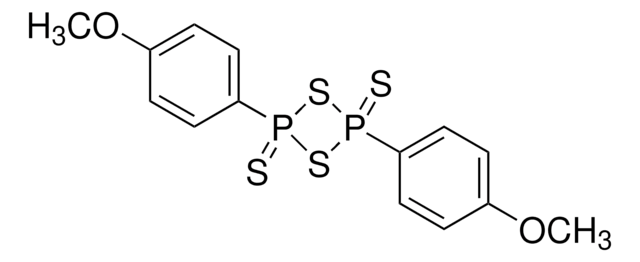Wichtige Dokumente
207942
Hydrazin Monohydrat
N2H4 64-65 %, reagent grade, ≥97%
Synonym(e):
Hydraziniumhydroxid
About This Item
Empfohlene Produkte
Qualität
reagent grade
Qualitätsniveau
Dampfdichte
>1 (vs air)
Dampfdruck
5 mmHg ( 25 °C)
Assay
≥97%
Form
liquid
Zusammensetzung
N2H4, 64-65%
Expl.-Gr.
99.99 %
Brechungsindex
n20/D 1.428 (lit.)
pH-Wert
10.6-10.7 (10 g/L)
bp
120.1 °C (lit.)
mp (Schmelzpunkt)
−51.7 °C (lit.)
Dichte
1.032 g/mL at 25 °C (lit.)
SMILES String
O.NN
InChI
1S/H4N2.H2O/c1-2;/h1-2H2;1H2
InChIKey
IKDUDTNKRLTJSI-UHFFFAOYSA-N
Suchen Sie nach ähnlichen Produkten? Aufrufen Leitfaden zum Produktvergleich
Allgemeine Beschreibung
Anwendung
Hydrazin-Monohydrat kann als Reduktionsmittel für folgende Reduktionen verwendet werden:
- Nitroarene in Gegenwart von Wasserstoffperoxid-funktionalisierten Kohlenstoffnanoröhrchen.
- 4-Iod-3-nitroanisol zur Bildung von 2-Iod-5-methoxyanilin.
- Graphenoxid (GO) zur Bildung von Graphen.
Ähnliches Produkt
Signalwort
Danger
Gefahreneinstufungen
Acute Tox. 2 Inhalation - Acute Tox. 3 Dermal - Acute Tox. 3 Oral - Aquatic Acute 1 - Aquatic Chronic 1 - Carc. 1B - Eye Dam. 1 - Flam. Liq. 3 - Skin Corr. 1B - Skin Sens. 1
Lagerklassenschlüssel
3 - Flammable liquids
WGK
WGK 3
Flammpunkt (°F)
100.4 °F - closed cup - (anhydrous substance)
Flammpunkt (°C)
38 °C - closed cup - (anhydrous substance)
Persönliche Schutzausrüstung
Faceshields, Gloves, Goggles, type ABEK (EN14387) respirator filter
Zulassungslistungen
Zulassungslistungen werden hauptsächlich für chemische Produkte erstellt. Für nicht-chemische Produkte können hier nur begrenzte Angaben gemacht werden. Kein Eintrag bedeutet, dass keine der Komponenten gelistet ist. Es liegt in der Verantwortung des Benutzers, die sichere und legale Verwendung des Produkts zu gewährleisten.
EU REACH SVHC Candidate List
EU REACH Annex XVII (Restriction List)
Hier finden Sie alle aktuellen Versionen:
Besitzen Sie dieses Produkt bereits?
In der Dokumentenbibliothek finden Sie die Dokumentation zu den Produkten, die Sie kürzlich erworben haben.
Kunden haben sich ebenfalls angesehen
Unser Team von Wissenschaftlern verfügt über Erfahrung in allen Forschungsbereichen einschließlich Life Science, Materialwissenschaften, chemischer Synthese, Chromatographie, Analytik und vielen mehr..
Setzen Sie sich mit dem technischen Dienst in Verbindung.












